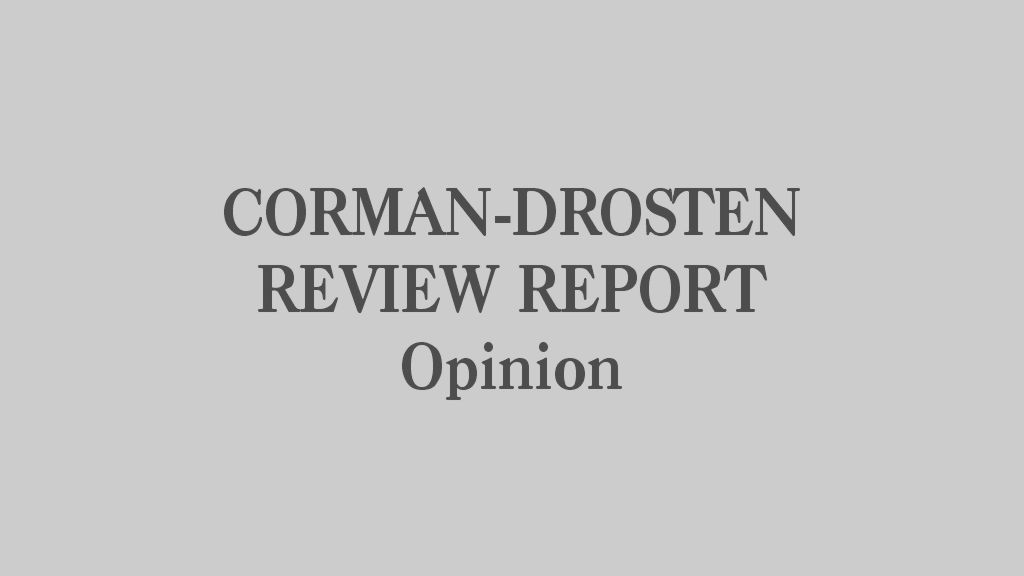What is a PCR test?: A PCR test stands for polymerase chain reaction test. This is a diagnostic test that determines if you are infected by analyzing a sample to see if it contains genetic material from the virus.
Before formal publication in a scholarly journal, scientific and medical articles are traditionally certified by “peer review.” In this process, the journal’s editors take advice from various experts (“referees”) who have assessed the paper and may identify weaknesses in its assumptions, methods, and conclusions. Typically a journal will only publish an article once the editors are satisfied that the authors have addressed referees’ concerns and that the data presented supports the conclusions drawn in the paper.” This process is as well described for Eurosurveillance [16].
The Corman-Drosten paper was submitted to Eurosurveillance on January 21st 2020 and accepted for publication on January 22nd 2020. On January 23rd 2020 the paper was online. On January 13th 2020 version 1-0 of the protocol was published at the official WHO website [17], updated on January 17th 2020 as document version 2-1 [18], even before the Corman-Drosten paper was published on January 23rd at Eurosurveillance.
Comment By Report Reader
It all started on January 10, 2020, when WHO reported that there is an outbreak in China caused by a novel coronavirus.
On Jan 17, 2020, The WHO recommended the use of the Corman-Drosten PCR test as a gold standard for detecting SARS-Cov-2 before the paper was even submitted for publishing.
On Jan 21 2020, the Corman-Drosten paper was submitted to the scientific journal Eurosurveillance describing the PCR test.
On Jan 22 2020, it was accepted for publication.
On Jan 23rd 2020, it was published.
Keep in mind that at the point when they started working on the PCR test, the genetic material of the virus was not yet sequenced.
“We aimed to develop and deploy robust diagnostic methodology for use in public health laboratory settings without having virus material available.”
“The PCR test was therefore designed using the genomic sequence of SARS-CoV” “Design and validation were enabled by the close genetic relatedness to the 2003 SARS-CoV.”
Listen to Kevin_McKernan @ 10:37 he estimates that they started working on the PCR test at least 2 months prior to the publication of the paper, so towards the end of Nov 2019.
“You have to recognise the body of the work that they presented is not something you can do in a week that looks like maybe 2 months worth of work, which of course begs the question of who tipped them off to making this, early, prior to actually being a pandemic.
The paper was not peer-reviewed. It was approved in one day. It takes on average 179 days to peer review an article.
Normally, peer review is a time-consuming process since at least two experts from the field have to critically read and comment on the submitted paper. In our opinion, this paper was not peer-reviewed. Twenty-four hours are simply not enough to carry out a thorough peer review. Our conclusion is supported by the fact that a tremendous number of very serious design flaws were found by us, which make the PCR test completely unsuitable as a diagnostic tool to identify the SARS-CoV-2 virus. Any molecular biologist familiar with RT-PCR design would have easily observed the grave errors present in the Corman-Drosten paper before the actual review process. We asked Eurosurveillance on October 26th 2020 to send us a copy of the peer review report. To date, we have not received this report and in a letter dated November 18th 2020, the ECDC as host for Eurosurveillance declined to provide access without providing substantial scientific reasons for their decision. On the contrary, they write that “disclosure would undermine the purpose of scientific investigations.” [24].
Conflict of interest was not declared: a) Drosten and his co-author Dr Chantal Reusken happen to be members of the editorial board of Eurosurveillance.
A final point is one of major concern. It turns out that two authors of the Corman-Drosten paper, Christian Drosten and Chantal Reusken, are also members of the editorial board of this journal [19]. Hence there is a severe conflict of interest which strengthens suspicions that the paper was not peer-reviewed. It has the appearance that the rapid publication was possible simply because the authors were also part of the editorial board at Eurosurveillance. This practice is categorized as compromising scientific integrity.
Olfert Landt, of Tib-Molbiol, the company that developed the PCR test being used, was also a co-author of the Drosten paper. “they distributed these PCR-test kits before the publication was even submitted.” They were already in business before the pandemic started.
We find severe conflicts of interest for at least four authors, in addition to the fact that two of the authors of the Corman-Drosten paper (Christian Drosten and Chantal Reusken) are members of the editorial board of Eurosurveillance. A conflict of interest was added on July 29 2020 (Olfert Landt is CEO of TIB-Molbiol; Marco Kaiser is senior researcher at GenExpress and serves as scientific advisor for TIB-Molbiol), that was not declared in the original version (and still is missing in the PubMed version); TIB-Molbiol is the company which was “the first” to produce PCR kits (Light Mix) based on the protocol published in the Corman-Drosten manuscript, and according to their own words, they distributed these PCR-test kits before the publication was even submitted [20]; further, Victor Corman & Christian Drosten failed to mention their second affiliation: the commercial test laboratory “Labor Berlin”. Both are responsible for the virus diagnostics there [21] and the company operates in the realm of real time PCR-testing.
In March 2020, the pandemic happened. The more we tested, the more cases we got, the more we assigned any death with a positive test to COVID19.
The world went into lockdown based on a fear of rising cases, asymptomatic transmission, widespread susceptibility, lack of pre-existing immunity, and lack of acquired immunity after Covid, with complete disregard to the fact that 80% of cases had no symptoms or mild symptoms and that mortality followed an age gradient. All these fears were not justified and contradicted our accumulated scientific knowledge. Basic immunological facts were put to question to disinform and confuse the innocent public.
Countries adopted an umbrella approach despite the fact that the profile of the vulnerable population was very clear since March 2020: older individuals with multiple comorbidities were at high risk of developing serious disease that could culminate in a negative outcome.
In June 2020, the casedemic happened. As the prevalence of C19 decreased and herd immunity approached, we started to tally up false (+) ‘cases’. The test was more likely to detect viral debris at this point than an infectious virus, especially with cycle thresholds above 30.
The WHO and Corman-Drosten protocol recommended a Ct of 45 cycles. Studies that conducted viral culture showed that with a PCR test Ct > 30, the tests were not detecting an infectious virus anymore. Yet governments turned a blind eye to these findings and never revised their Ct.
On the 27th of November 2020, 23 scientists finally reviewed the Corman-Drosten paper and have demanded it’s retraction.
See Original Online Report Here and Report PDF link below:
This has been Big Pharma and biotech fiasco enabled by scientists that lack integrity and are after fame and greed. On the back of this fiasco, power-craving politicians seized the moment and dug their claws into the lives of regular people like you and me.
Unfortunately, this will continue until you understand that this has been a big fraud. It’s time we end this manufactured pandemic and make sure that history doesn’t repeat itself again.
Read:
By Allen (from a comment on the CORMAN-DROSTEN REVIEW REPORT Website)






